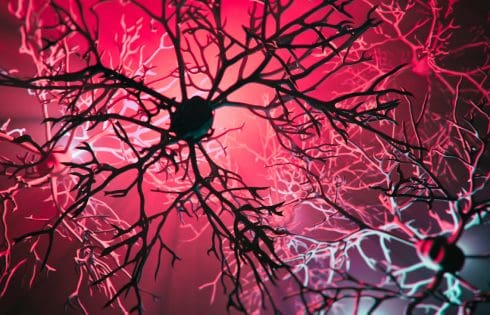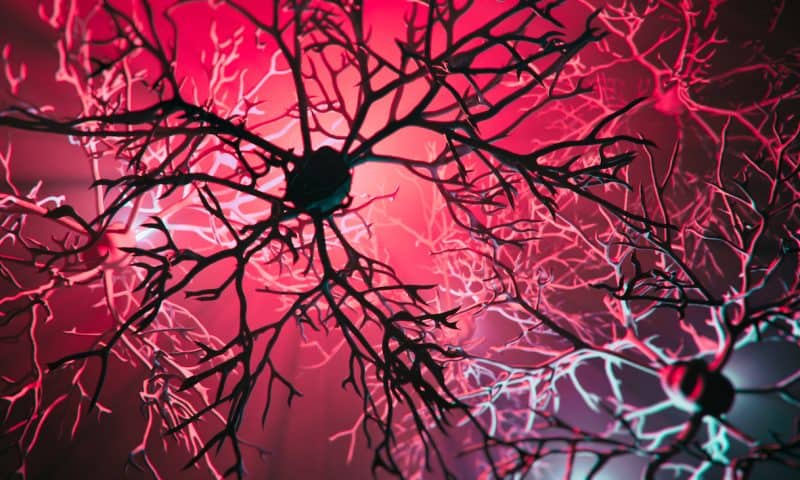
Research in a mouse model of Huntington’s disease has shown that the adult brain can generate new neurons that integrate into key motor circuits. Building on previous work, the new findings, by a team at the Center for Translational Neuromedicine, University of Rochester Medical Center (URMC), demonstrated that stimulating natural brain processes may help repair damaged neural networks in Huntington’s disease and potentially other disorders characterized by the loss of certain populations of neurons.
“Our research shows that we can encourage the brain’s own cells to grow new neurons that join in naturally with the circuits controlling movement,” said Abdellatif Benraiss, PhD, a research associate professor in the URMC lab of Steve Goldman, MD, PhD, at the Center for Translational Neuromedicine. “This discovery offers a potential new way to restore brain function and slow the progression of these diseases.” Benraiss is a senior author of the team’s study in Cell Reports, titled “Newly generated striatal neurons rescue motor circuitry in a Huntington’s disease mouse model,” in which they concluded “Together, these data indicate that induced neurogenesis may restore multi-synaptic circuits in the adult brain, offering a regenerative strategy for the treatment of HD.”
It had previously been long believed that the adult brain could not generate new neurons. However, it is now understood that niches in the brain contain reservoirs of progenitor cells capable of producing new neurons. While these cells actively produce neurons during early development, they switch to producing support cells called glia shortly after birth. One of the areas of the brain where these cells congregate is the ventricular zone, which is adjacent to the striatum, a region of the brain that is devastated by Huntington’s disease. “Huntington’s disease (HD) is a fatal neurodegenerative disease characterized by the selective loss of neostriatal medium spiny neurons (MSNs),” the authors explained.
The idea that the adult brain retains the capacity to produce new neurons—adult neurogenesis—was first described by Goldman and others in the 1980s while studying neuroplasticity in canaries. Songbirds such as canaries are unique in the animal kingdom in their ability to lay down new neurons as they learn new songs. The research in songbirds identified proteins—one of which was brain-derived neurotrophic factor (BDNF)—that direct progenitor cells to differentiate and produce neurons.
Further research in Goldman’s lab had shown that new neurons were generated when BDNF and another protein, Noggin, were delivered to progenitor cells in the brains of mice. These cells then migrated to a nearby motor control region of the brain—the striatum—where they developed into cells known as medium spiny neurons, the major cells lost in Huntington’s disease. Benraiss and Goldman also demonstrated that the same agents could induce new medium spiny neuron formation in primates.
“We previously reported that intraventricular delivery of BDNF and Noggin elicits the sustained recruitment of new neurons from subependymal neuronal progenitors in both rodents and non-human primates,” the team explained. “In rodents, which have been more extensively studied, the new neurons differentiate as MSNs that project axons to their natural targets in the globus pallidus (GP).”
What has been unclear is the extent to which newly generated medium spiny neurons integrate into the adult brain’s striatal networks. For their newly reported research, Goldman, Benraiss, and colleagues used wild-type (WT) mice and a mouse model of Huntington’s disease (R6/2 mice), to follow the fate of genetically tagged new neurons recruited to the striatum after intraventricular infusion of BDNF and Noggin. The researchers used a genetic tagging method to mark new cells as they were created, which allowed them to follow them over time as they developed new connections. The technologies applied enabled the researchers to map the connections between the new neurons, their neighbors, and other brain regions. Employing optogenetics techniques, the researchers turned the new cells on and off, confirming their integration into broader brain networks important for motor control.
Their studies demonstrated that the newly generated neurons connect with the complex networks in the brain responsible for motor control, replacing the function of the neurons lost in Huntington’s. “… using circuit-targeted optogenetic manipulation coupled with calcium imaging and electrophysiological recordings, we found that newly recruited striatal neurons indeed integrated into the motor cortico-striato-pallidal circuit and did so in a similar manner to host MSNs,” the scientists reported. “In addition, using chemogenetic activation of the newly generated neurons, we showed that these new striatal neurons contributed to motor behavior.”
Jose Cano, PhD, a postdoctoral associate in the Goldman lab and lead author of the study, added, “In this paper, we used a combination of electrophysiology, optogenetics, and mouse behavior to show that these cells are not only produced in the adult brain but functionally restore motor circuits in both healthy mice and in the context of Huntington’s disease.”
The collective findings indicate that a possible treatment for Huntington’s disease might be to encourage the brain to replace lost cells with new, functional ones and restore the brain’s communication pathways. “Together, these data strongly suggest that new neurons recruited in response to BDNF and Noggin treatment enable the reconstitution of multi-synaptic circuits in the adult brain and, in turn, that these reconstituted striatal circuits account for the slowing in disease progression previously noted in BDNF-Noggin-treated HD mice,” the authors concluded.
“Taken together with the persistence of these progenitor cells in the adult primate brain, these findings suggest the potential for this regenerative approach as a treatment strategy in Huntington’s and other disorders characterized by the loss of neurons in the striatum,” said Benraiss.
The authors further suggest that this approach could also be combined with other cell replacement therapies. Research in Goldman’s lab has shown that glial cells called astrocytes also play an important role in Huntington’s disease. These cells do not function properly in the disease and contribute to the impairment of neuronal function. The researchers have found that replacing the diseased glial cells with healthy ones can slow disease progression in a mouse model of Huntington’s. These glial replacement therapies are currently in preclinical development.

